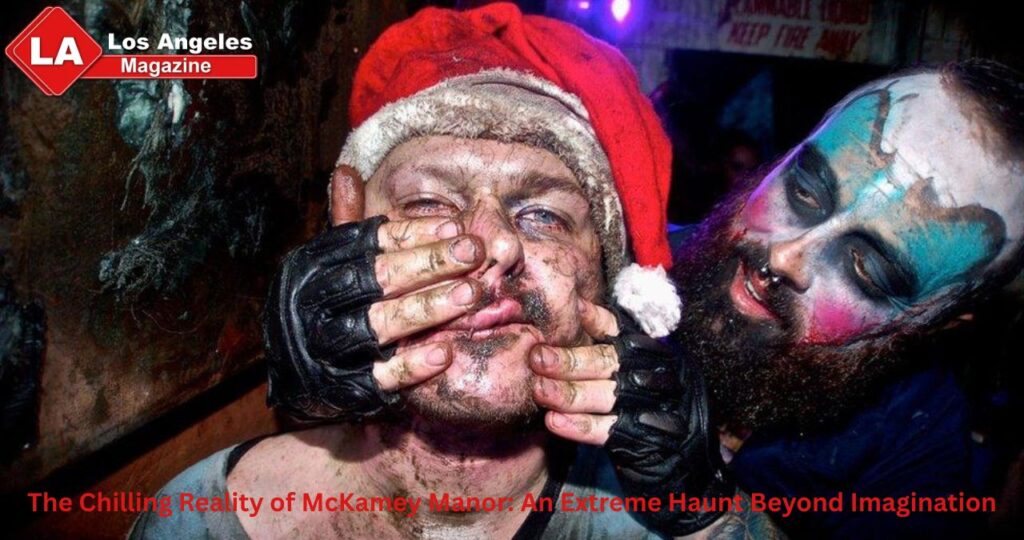In the world of haunted attractions, few names evoke as much controversy and curiosity as McKamey Manor. Often described as the most extreme haunted house experience in the world, McKamey Manor has become a dark legend within horror culture. Unlike traditional haunted houses that rely on jump scares, eerie decor, and theatrical performances, McKamey Manor pushes its participants into the realm of physical and psychological endurance. It is not just a haunted attraction—it is a full-scale psychological experiment that challenges the boundaries of fear, consent, and human resilience.
The Concept Behind McKamey Manor
Founded by Russ McKamey, a Navy veteran and lifelong horror enthusiast, McKamey Manor was conceived as a performance art project intended to test the limits of terror. The attraction initially operated in San Diego, California, before relocating to Summertown, Tennessee, and later expanding to Huntsville, Alabama. Unlike other haunted houses, McKamey Manor is not a business in the traditional sense. There is no ticket price. Instead, visitors are asked to donate pet food for local shelters, a requirement that adds an oddly humane twist to a notoriously brutal experience.
Participants must be over 21 years old, sign an extensive 40-page waiver, and provide medical clearance before taking part. They must also pass a background check and a screening interview conducted by McKamey himself. This rigorous process is designed to ensure that every participant is aware of what they are getting into, though many former visitors claim that no amount of preparation can truly capture what awaits inside.
What Happens Inside
The details of what actually happens inside McKamey Manor remain partly shrouded in mystery. Each participant signs a contract agreeing not to reveal specific events, and McKamey records every experience on video to protect himself from legal action. However, those who have gone through the experience—or tried to—describe it as a blend of physical endurance, sensory deprivation, and psychological torment.
Participants have reported being bound, submerged in water, covered with insects, force-fed unknown substances, and subjected to verbal humiliation. The actors are not traditional performers but rather individuals trained to simulate real fear and physical distress. Every scenario is customized to exploit each participant’s deepest phobias, discovered during the pre-interview process. This means that no two experiences are alike, and each is tailored to inflict maximum psychological impact.
Despite these horrifying accounts, McKamey insists that no one is actually harmed. He argues that the entire event is a mind game, where fear and suggestion are the true instruments of torture rather than physical violence. Yet the bruises, tears, and psychological trauma reported by many participants tell a more complex story—one that blurs the line between entertainment and abuse.
The Waiver and Consent Controversy
Perhaps the most infamous part of McKamey Manor is its waiver, a document often described as more intense than the experience itself. Spanning dozens of pages, it lists everything from possible injuries and emotional trauma to potential tooth loss or bone fractures. Participants must acknowledge that they are voluntarily agreeing to these risks, which theoretically protects the Manor from legal repercussions.
However, critics argue that true consent is questionable in an environment designed to overwhelm and disorient. When someone is terrified, deprived of sleep, or physically restrained, their ability to withdraw consent becomes compromised. Some participants claim they tried to quit using the established “safe word,” only to be ignored or delayed in being released. McKamey, in defense, insists that the waiver and video recordings prove that all participants are aware and willing throughout the process. Yet the debate continues, raising ethical questions about whether consent can remain valid in such extreme psychological conditions.
Public Reactions and Backlash
Public opinion on McKamey Manor is sharply divided. To some, it is an avant-garde piece of interactive horror art that explores the psychology of fear in a controlled environment. To others, it is an unethical operation that disguises human torture as entertainment. Petitions have circulated online demanding that the attraction be shut down, labeling it a “torture chamber” rather than a haunted house. Local authorities have received complaints, though McKamey has consistently managed to operate within legal limits by relying on participant waivers.
Psychologists and ethicists have also weighed in, questioning the motives behind both the creator and the participants. Why would anyone voluntarily subject themselves to such distress? For some thrill-seekers, McKamey Manor represents the ultimate test of courage—a chance to confront fear in its purest form. For others, it serves as an escape from daily monotony, a bizarre form of self-exploration where pain and terror replace boredom and routine.
The Psychological Aspect of Fear
Fear is a complex emotion deeply rooted in human survival. Traditional haunted houses manipulate fear through sudden shocks, eerie sound effects, and supernatural imagery. McKamey Manor, however, goes beyond that—it seeks to deconstruct the human psyche. The experience forces participants to confront loss of control, helplessness, and humiliation, tapping into primal fears that no amount of rational thinking can overcome.
From a psychological perspective, McKamey Manor functions as a kind of exposure therapy taken to the extreme. By forcing participants to face their fears head-on, it theoretically allows them to desensitize to those fears. Yet without trained professionals and with the use of physical coercion, this approach can easily backfire, causing long-term trauma rather than healing. The question, then, is whether the attraction serves as a legitimate exploration of human emotion or merely capitalizes on suffering for shock value.
Russ McKamey’s Defense
Russ McKamey has always stood by his creation, calling it a passion project and psychological study rather than a business venture. He records every session for transparency and often shares edited clips online, portraying participants laughing or expressing relief afterward. McKamey emphasizes that no one is ever forced to participate and that the experience is fully legal under U.S. law due to the signed consent forms.
He also claims that his goal is not to harm but to create a safe space for extreme adventure, where people can discover how far they can go before breaking. He sees the Manor as a mirror reflecting each participant’s mental limits. McKamey himself remains unfazed by the criticism, asserting that his attraction is misunderstood by the media and that those who truly understand it view it as art rather than cruelty.
Ethical Questions and Cultural Impact
The rise of McKamey Manor reflects society’s shifting relationship with entertainment. In an era of reality television, horror survival games, and viral challenges, audiences crave authenticity—something that feels raw and unscripted. McKamey Manor delivers that authenticity, but at a moral cost. It challenges the boundaries between performance and reality, consent and coercion, thrill and trauma.
Ethically, it raises important questions: Can an experience that deliberately inflicts suffering ever be considered art? Is voluntary participation enough to justify psychological torment? And what responsibility does the creator bear when participants emerge scarred—emotionally or physically? These debates continue to define McKamey Manor’s legacy, making it less a haunted attraction and more a cultural phenomenon that forces society to confront its fascination with pain and fear.
Conclusion
McKamey Manor stands as one of the most polarizing creations in the history of entertainment. It exists at the crossroads of horror, psychology, and ethics—both celebrated for its innovation and condemned for its extremity. Whether one sees it as a twisted form of art or a dangerous psychological experiment, its impact on the world of horror is undeniable. It forces us to ask why we seek fear, what limits we are willing to cross for adrenaline, and whether confronting darkness truly helps us understand ourselves—or merely consumes us.



